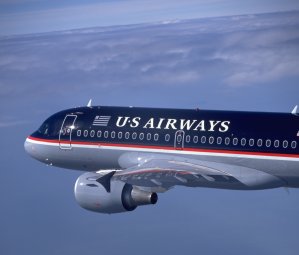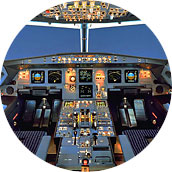| RTS - RECURRENT TRAINING
SIMULATOR DAY 2 |
RTS Briefing Items:
- RNAV
(RNP) Approaches
- Engine Failure during Critical Phase
- CAT III
Approaches
- Non-ILS Approach Review
- SOPs
|
| RTS SUMMARY |
| SPOT |
PF |
MANEUVERS |
REFERENCE |
| 1 |
CREW |
Single-engine taxi |
* 2c.3.9 Single Engine Taxi |
| 2 |
CA |
Low Visibility Takeoff, CAT II Autoland, Go Around and
Landing |
* OM1 2d.2: Low vis TO
* OM1 2f: ILS CAT II/III
*
QRH OD-13 Takeoff Alternate / Minimums
* QRH OD-17 Approach
Minimums / CAT II/III
* Simulator Callouts Guide: Takeoff, ILS CAT
II/III, Go-Around |
| 3 |
CA |
Takeoff with Gusts, VOR Approach, Pneumatics, Air
Conditioning, and Pressurization Non-Normal, Landing with Gusts |
* Supplemental Manual:
* OM1 2f.9 Managed Non-ILS Approaches
* QRH OD-31
VOR/NDB Approaches
* Simulator Callouts Guide: Takeoff, Managed
Non-ILS Approach |
| 4 |
FO |
Takeoff, Engine Failure (Second Segment), Single
Engine CAT I ILS Approach, Landing |
* OM1 2d.8: Loss of
Thrust At or Above V1
* OM1 2f.4.4: Engine-Out Procedures
* OM1 2f.4
ILS CAT I
* OM1 2.9.5: Automation Levels
* ECAM Trainer
*
Simulator Callouts Guide: Loss of Thrust; CAT I ILS |
| 5 |
CA |
Takeoff, Engine Failure/Fire (Between V1 and V2),
Single Engine CAT I ILS Approach, Landin |
* OM1 2d.8: Loss of
Thrust At or Above V1
* OM1 2f.4.4: Engine-Out Procedures
* OM1 2f.4
ILS CAT I
* OM1 2.9.5: Automation Levels
* ECAM Trainer
*
Simulator Callouts Guide: Loss of Thrust; CAT I ILS |
| 6 |
FO |
Gusty Crosswind Takeoff, Electric Non-Normal,
RNAV (RNP) AR Approach, Gusty Crosswind Landing |
* OM1 2f.9.5 Managed
Non-ILS Approaches
* QRH OD-28 thru 31 RNAV Approaches
* Simulator
Callouts Guide: Takeoff, Managed Non-ILS Approach |
| 7 |
FO |
LOC Approach 22R, Go Around/Missed Approach, Landing |
* OM1 2f.9.5
Managed Non-ILS Approaches
* OM1 2g: Go Around
* QRH OD-29
RNAV Approaches
* Simulator Callouts Guide: Takeoff, Managed Non-ILS
Approach |
| 8 |
CA |
KORD ILS PRM Y 10R PRM APPROACH AND BREAKOUT |
* OM 1 2f.8 PRM Approach
* Simulator Callouts
Guide: PRM Breakouts |
| MANEUVERS OBSERVATION (MO)
DAY 3 |
| SPOT |
PF |
MANEUVERS |
REFERENCE |
| 1 |
CA |
CA Low Visibility Takeoff, KMCO ILS CAT
III 36R Approach, Landing |
* KMCO ILS 36R (21-6) plate
* OM1 2d.2:
Low vis TO
* OM1 2f: ILS CAT II/III
* QRH OD-13 Takeoff Alternate /
Minimums
* QRH OD-17 Approach Minimums / CAT II/III
*
Simulator Callouts Guide: Takeoff, ILS CAT II/III, Go-Around |
| 2 |
FO |
Low Visibility RTO, Low Visibility
Takeoff, KMCO RNAV (GPS) 36L Approach, Landing |
* KMCO RNAV (GPS) 36L (22-7) plate
*
OM1 2d.2: Low Visibility TO
* OM1 2d.6: Rejected Takeoff
* OM1
2f.9.8 Managed Non-ILS Approaches
* QRH OD-28 RNAV Approaches
* Simulator Callouts Guide: Takeoff, Rejected Takeoff, Managed Non-ILS
Approach |
| 3 |
FO |
Engine Failure Second Segment Climb, Single Engine
Pattern, Go-Around\Missed Approach, KMCO CAT I ILS 36R, Landing |
* KMCO ILS 36R (21-6) plate
* OM1 2d.8:
Loss of Thrust At or Above V1
* OM1 2f.4.4: Engine-Out Procedures
*
OM1 2f.4 ILS CAT I
* OM1 2g: Go Around & Landing
* Simulator Callouts Guide: Loss of Thrust; CAT I
ILS |
| 4 |
CA |
Takeoff with Gusts, Hydraulic Failure, KMCO LOC 36R
Approach, Go-Around/Missed Approach, Landing |
* KMCO LOC 36R (21-6) plate
* OM1
2f.9.9 Non-Managed Non-ILS Approaches
* OM1 2g: Go Around & Landing
* QRH OD-33 Non-Managed Non-ILS Approaches
* ECAM Supplemental Manual: HYD
* Simulator Callouts Guide: Takeoff, Managed Non-ILS
Approach, Go-Around |
| 5 |
CA |
CA Engine Failure at V1, Single Engine
KMCO CAT I ILS 36R Landing |
* KMCO ILS 36R (21-6) plate
* OM1 2d.8:
Loss of Thrust At or Above V1
* OM1 2f.4.4: Engine-Out Procedures
*
OM1 2f.4 ILS CAT I
* OM1 2.9.5: Automation Levels
* ECAM Trainer
* Simulator Callouts Guide: Loss of Thrust; CAT I ILS |
| 6 |
|
KDFW-KEGE Departure, SID, Door Non-Normal |
* OM 1 9: Non-Normals |
| 7 |
|
KDFW RNAV (RNP) Z RWY 13R Approach, Missed Approach |
* OM1
2f.9.8 Managed Non-ILS Approaches
* QRH OD-28 RNAV Approaches
* Simulator Callouts Guide: Managed Non-ILS
Approach, Go-Around |
| 8 |
|
KDFW 18L Takeoff, Departure, Brakes Non-Normal |
* OM 1 9: Non-Normals |
| 9 |
|
KDFW 18L Visual Approach, Gusty Winds |
* OM1 2f.2: Visual Approach |
| 10 |
|
KEGE LDA 25 Visual Approach to Uncontrolled Field, Go
Around, Visual Pattern and Landing |
* OM1 2f.2: Visual Approach
* OM1 2g: Go Around & Landing |
| CQ LINE OPERATIONAL
EVALUATION (LOE/RLE) DAY 4 |
Review these Non-Normals in the ECAM
Supplemental Manual:
- AUTO FLT YAW DAMPER SYS FAULT
- AUTO FLT FCU
1 FAULT
- CA PFD DU Failure
- AIR ENG BLEED LEAK |
| You will fly
one of the following six RLE legs: |
| RLE 15-1 |
KBOS to KDCA: Runway change after start of
taxi. AUTO FLT YAW DAMPER SYS FAULT in descent resulting in Alternate Law
with no AP. Approach planned for DCA ILS 01 in Direct Law, FLAPS 3 with
800 OVC and 3 SM. Crew may decide to land in DCA or request IAD. Request
radar vectors to IAD ILS 01R. |
| RLE 15-2 |
KBOS to KDCA: Runway change after start of
taxi. AUTO FLT FCU 1 FAULT in cruise. Radar vectors to DCA River Visual.
When lined up on final go-around with vectors for visual approach 01. |
| RLE 15-3 |
Runway change after start of taxi.CA PFD
DU Failure requiring a divert to a suitable alternate. CA ND automatically
switches to PFD. Visibility deteriorates in holding from 1200 RVR to 1000
RVR (below DCA CAT II minimums). Vectors to IAD ILS 01R. |
| RLE 15-4 |
FMS EO procedure for departure. AUTO FLT
YAW DAMPER SYS FAULT in descent resulting in Alternate Law with no AP.
Plan approach for BOS ILS 33L in Direct Law, FLAPS 3 with 800 OVC and 3
SM. |
| RLE 15-5 |
FMS EO procedure for departure. AUTO FLT
FCU 1 FAULT in cruise. Approach is the Light Visual 33L. At 500 feet
go-around with vectors for visual approach to 33L. |
| RLE 15-6 |
FMS EO procedure for departure, CA PFD DU
failure requires diversion to a suitable airport. CA ND automatically
switches to PFD. Visibility deteriorates in holding from 800 RVR to 500
RVR. Vectors to KBDL ILS 24. |
| RAD SUMMARY
DAY 4 |
| 1 |
FO |
Unreliable Airspeed |
* QRH 14-QA Unreliable Speed |
| 2 |
CA/FO |
Windshear/Microburst on Takeoff and Approach KLAS - FO
on Takeoff prior to VR 26R, CA on Approach 26L |
* OM 1 2i.3 Windshear Precautions and Recovery
*
Simulator Callouts Guide: Windshear |
| 3 |
CA/FO |
KLAS 26R Takeoff/ SID/ Upset Recovery (FO), Manually
Controlled Slow Flight/Recovery from Full Stall (Both) |
* OM1 2i.6 Stall Recovery
* Simulator Callouts
Guide: Stall REcovery |
| 4 |
|
Upset Recovery (Maneuver Based) |
* OM 1 2i.7: Upset Recovery
* Simulator Callouts
Guide: Upset Recovery |
| 5 |
|
Manually Controlled Instrument Arrival and Upset
Recovery |
* OM 1 2i.7: Upset Recovery
* Simulator Callouts Guide: Upset Recovery |
| 6 |
|
High Altitude, High Energy Go Around |
|

